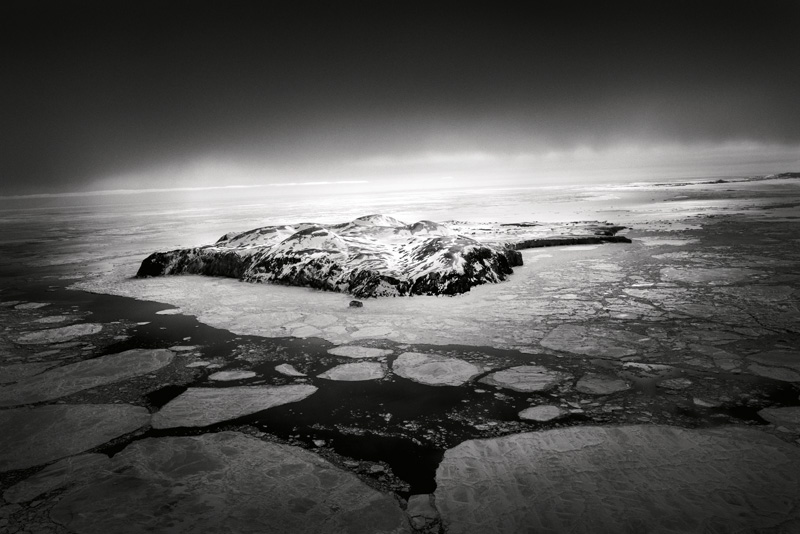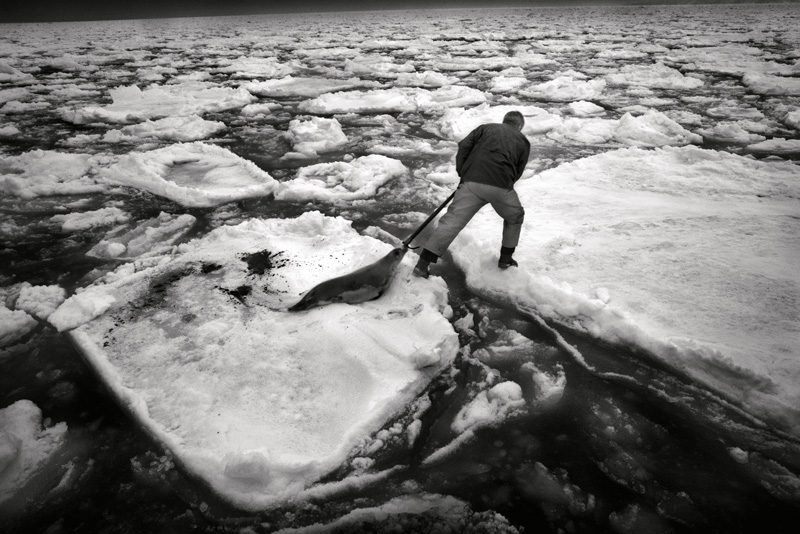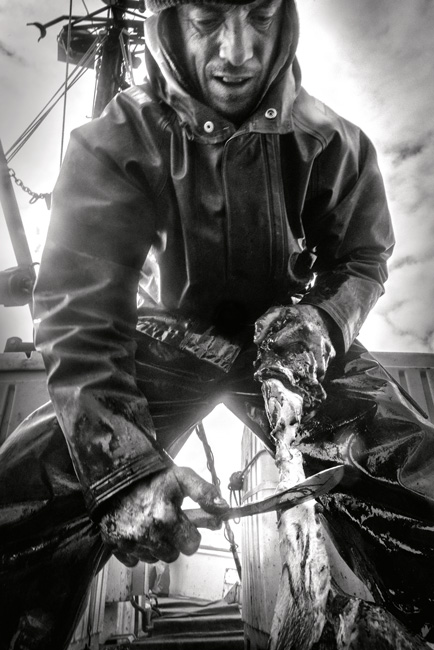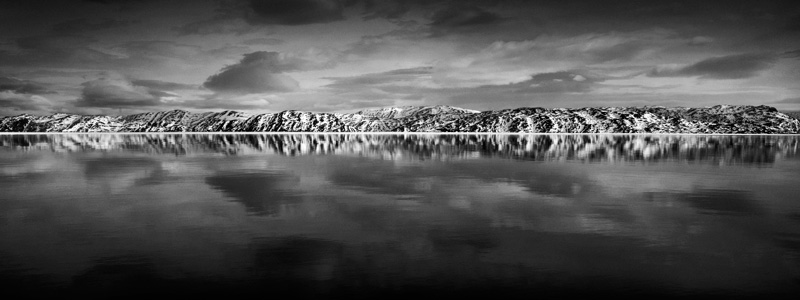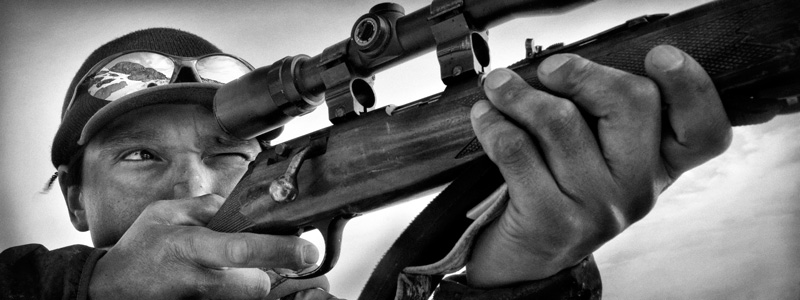Par Mona Hakim
HAKAPIK did not go unnoticed during its presentation at Occurrence.1 The subject was an attention-grabber: a report on the seal hunt by Yoanis Menge, a photographer from Îles de la Madeleine who totally immersed himself in the lives of groups of hunters off the coast of the Canadian North. There was no resemblance here to the usual conspicuous and corrosive reporting of this controversial subject. The exhibition, with its forty large-format black-and-white photographs, panoramic views, and figures in action, approached the daily life of these isolated communities from a peaceable, enlightened point of view. Laid out generously on the walls of the gallery, these photographs are gripping and moving.
Menge was initiated into the documentary school as an intern at the Magnum agency, under the wing of Josef Koudelka and Bruno Barbey. It seems that he sees photography as an important social tool. HAKAPIK is not his first report, despite his relatively young age: he had already photographed in El Salvador and Mali. He then felt the need to return to Îles de la Madeleine and become involved in the hunt, intending to counter the negative and erroneous image conveyed by the constantly expanding anti-hunt lobby.
By looking at the hunt from the inside – on board fishing boats, side by side with crew members and following their customary activities as closely as possible – Menge, with a sympathetic and respectful gaze, gave a distinctive inflection to the project. It was a sizeable challenge for him, as he had to deal with the double position of hunter and picture taker in the field. Seas – both calm and rough – pack ice, boats, harpooned seals, hunting tools, but also shacks, dining tables, and omnipresent portraits – individual and group – formed the backdrop to what became a personal journal. Thus, the hanging of the photographs by group and by superimposition pointedly avoids an overwhelming effect by forming a homogeneous corpus within which each image, like each combination, dialogues with another, leading us through the sequences of events.
Photographic techniques also play a fundamental role in this regard. Menge channels his subjects in tight framings, close-up views, high angles, and wide shots that reduce the depth of field and deliberately take the viewer into the heart of the action. Similarly, sky and sea tend to meld together, and the horizon lines, barely perceptible, tip as the boats heel over in the waves. Backlighting, high contrast, and sustained chiaroscuro are added to the enveloping sense of the scenes, and the effect is enhanced by the black-and-white prints. The exclusion of colour, like the other techniques, draws the eye to the people’s expressions, the intensity of their gestures, and the texture of their environment buttressed by the contrasting light. Menge thus diverts the simple perception of cruelty and senselessness conveyed by the bloody-coloured coverage of the hunt, and he is able to extract the human and cooperative dimension implicit in this stigmatized trade. Although these images convey dramatic tension, even a certain theatricality, the intention seems to be to exalt a sense of the protagonists’ labour, recklessness, and courage. To highlight the experience, Menge made a short film that plunges us into the close quarters of the fishing boat, between the ocean swell and the ineluctable fate of the animals.
Menge rightly claims the Quebec tradition of direct and sensitive filmmakers such as Pierre Perreault and Michel Brault. He is also a member of a younger generation of photographers issuing from the social documentary genre who take a position as auteur, radically opposed to the role of photojournalists. This attitude, of course, is not new – it is difficult to ignore the influence of Menge’s mentor, Koudelka – but this more contemporary type of report challenges the instantaneity, excess, and deceit that imbue current media news, and exploits what diverse facets of creativity can provide as a frame for interpretation. There is thus a renewed focus and the assumed intent of preserving the social pertinence of photography. Some artists work through casting a view back at events; others, like Menge, draw close to individuals by participating in their activities, and their photographs are often flooded with humanity, without ever slipping into complacent or distracted reporting. And this is the strength of the Hakapik project. A skilful aesthetic position taken by Menge, a mastery of the medium, a sincere involvement with the subject captured, and a sense of ethics have led to a rigorous balance between his personalized approach and the facts to which he is always firmly devoted.
It should be noted that there is a large book accompanying the exhibition, testifying to the true scope of the initial project. It contains a narrative composed of more than eighty high-quality reproductions, with each page-sequence allowing intimate access for better comprehension of the ancestral rituals in the closely woven communities in Îles de la Madeleine, Newfoundland, and Nunavut. A preface written by Michel Campeau, a very enlightening conversation between the photographer and Serge Allaire on the issues involved in such a project, and almanacs of the seal hunt gathered by Gil Thériault complete this beautiful documentary book – an authentic auteur’s photography book. Menge is a truly engaged photographer, and there is more to come.
Translated by Käthe Roth
Yoanis Menge was born in 1981, and he lives and works in Îles de la Madeleine. He studied photography at Cégep de Matane. In 2002, he produced his first photo report, on prostitution in El Salvador. Subsequently, he continued his training at the Magnum Photos agency in Paris, where he worked for four years as assistant to photographers Josef Koudelka and Bruno Barbey. In 2015, Menge received the Prix du CALQ – Artwork of the Year in Îles de la Madeleine for his photographic installation Rouge sur blanc presented by the artist-run centre AdMare. Menge is a member of KAHEM, a collective of independent Quebec photographers.
yoanis.squarespace.com
Mona Hakim is an art historian, critic, and independent curator. She taught history of art and of photography at the college level from 1996 to 2015. Her research and writing addresses contemporary art with a more sustained interest in issues related to photography. She has organized retrospective and group exhibitions in Quebec and abroad, and she is currently working as co-curator on an exhibition about major trends in Quebec photography over the last fifteen years.




